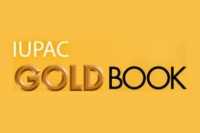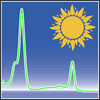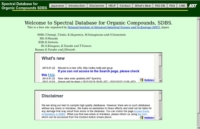IUPAC Compendium of Chemical Terminology – the Gold Book
The Compendium is popularly referred to as the “Gold Book”, in recognition of the contribution of the late Victor Gold, who initiated work on the first edition. It is one of the series of IUPAC “Colour Books” on chemical nomenclature, terminology, symbols and units (see the list of source documents), and collects together terminology definitions from IUPAC recommendations already published in Pure and Applied Chemistry and in the other Colour Books.
Terminology definitions published by IUPAC are drafted by international committees of experts in the appropriate chemistry sub-disciplines, and ratified by IUPAC’s Interdivisional Committee on Terminology, Nomenclature and Symbols (ICTNS). In this edition of the Compendium these IUPAC-approved definitions are supplemented with some definitions from ISO and from the International Vocabulary of Basic and General Terms in Metrology; both these sources are recognised by IUPAC as authoritative. The result is a collection of nearly 7000 terms, with authoritative definitions, spanning the whole range of chemistry.
Some minor editorial changes were made to the originally published definitions, to harmonise the presentation and to clarify their applicability, if this is limited to a particular sub-discipline. Verbal definitions of terms from Quantities, Units and Symbols in Physical Chemistry (the IUPAC Green Book, in which definitions are generally given as mathematical expressions) were developed specially for this Compendium by the Physical Chemistry Division of IUPAC. Definitions of a few physicochemical terms not mentioned in the Green Book were added at the same time (referred to here as Physical Chemistry Division, unpublished).
The first reference given at the end of each definition is to the page of Pure Appl. Chem. or other source where the original definition appears; other references given designate other places where compatible definitions of the same term or additional information may be found, in other IUPAC documents. The complete reference citations are given in the appended list of source documents. Highlighted terms within individual definitions link to other entries where additional information is available.
PhotochemCAD – Calculational modules and a database of absorption and emission spectra for diverse compounds
PhotochemCAD™ is a program of calculational modules and accompanying database of spectra aimed at advancing the photosciences. A streamlined version of the same database of spectra can now be viewed on our new website. The user is directed to the following journal articles for full description of the program and database:
1. “PhotochemCAD 3: Diverse Modules for Photophysical Calculations with Access to Multiple Spectral Databases,” Taniguchi, M.; Du, H.; Lindsey, J. S. Photochem. Photobiol. 2018, 94, 277–289. – describes the overall organization of the program and provides a complete description of each module, including the formulas for all calculations.
2. “Database of Absorption and Fluorescence Spectra of >300 Common Compounds for Use in PhotochemCAD,” Taniguchi, M.; Lindsey, J. S. Photochem. Photobiol. 2018, 94, 290–327. – provides literature data for each spectrum including 720 references in total to the original scholarly literature.
Halas Nanophotonics Group – Rice University – Energy Unit Conversions
As the field of nanophotonics continues to become more interdisciplinary, it is essential to be able to convert between different units of energy by memory. When reading papers, attending talks, having conversations with colleagues, and answering questions in your own presentations, you should always know exactly where a certain measurement lies in the electromagnetic spectrum, regardless of units.
Spectral Database for Organic Compounds, SDBS
We are doing our best to compile high quality databases. However, there are no such databases without any errors or mistakes. We make no warranties to those effects and shall not be liable for any damage that may result from errors in the database. You can check the page Known Errors of Mistakes in SDBS. When you find new errors or mistakes, please inform us by email (see this page for contact details).
Access to this database is free of charge. However we request visitors to our database not to download more than 50 spectra and/or compound information in one day. All accesses are recorded. It is prohibited that you use any information of SDBS for profit-making or commercial use without obtaining proper permission from us. If more spectra are required for some specific purpose or commercial use, you should consult us and describe the intended usage or purpose of our SDBS.





